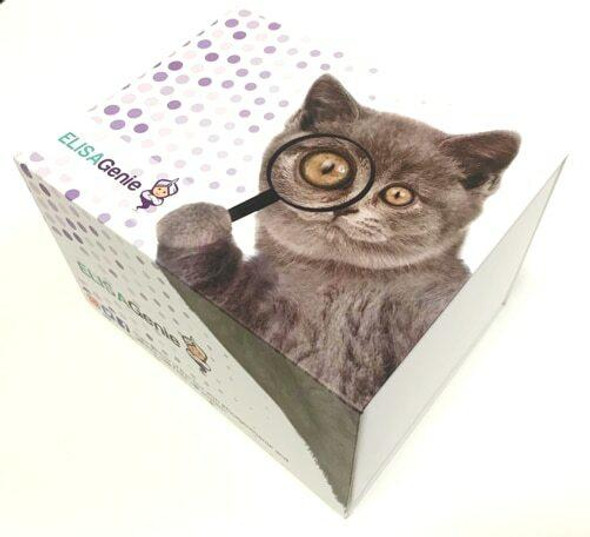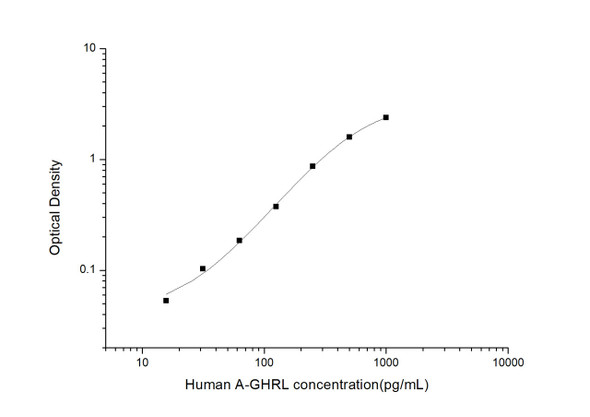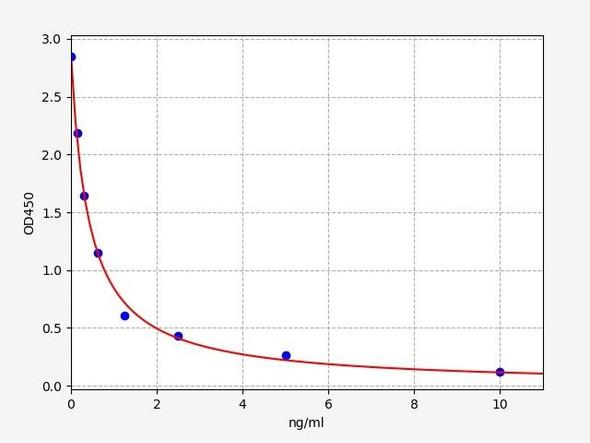Human Cell Biology ELISA Kits 1
Human GHRL (Ghrelin) ELISA Kit (HUES02865)
- SKU:
- HUES02865
- Product Type:
- ELISA Kit
- Size:
- 96 Assays
- Uniprot:
- Q9UBU3
- Sensitivity:
- 0.09ng/mL
- Range:
- 0.16-10ng/mL
- ELISA Type:
- Competitive
- Synonyms:
- GHRL, MTLRP, Ghrelin
- Reactivity:
- Human
- Sample Type:
- Serum, plasma and other biological fluids
- Research Area:
- Cell Biology
Description
| Assay type: | Competitive-ELISA |
| Format: | 96T |
| Assay time: | 2.5h |
| Reactivity: | Human |
| Detection Method: | Colormetric |
| Detection Range: | 0.16-10 ng/mL |
| Sensitivity: | 0.10 ng/mL |
| Sample Volume: | 50µL |
| Sample Type: | Serum, plasma and other biological fluids |
| Specificity: | This kit recognizes Human GHRL in samples. No significant cross-reactivity or interference between Human GHRL and analogues was observed. |
This ELISA kit uses Competitive-ELISA as the method. The microtiter plate provided in this kit has been pre-coated with Human GHRL. During the reaction, Human GHRL in the sample or standard competes with a fixed amount of Human GHRL on the solid phase supporter for sites on the Biotinylated Detection Ab specific to Human GHRL. Excess conjugate and unbound sample or standard are washed from the plate, and Avidin conjugated to Horseradish Peroxidase (HRP) are added to each microplate well and incubated. Then a TMB substrate solution is added to each well. The enzyme-substrate reaction is terminated by adding Stop Solution and the color change is measured spectrophotometrically at a wavelength of 450 nm ± 2 nm. The concentration of Human GHRL in the samples is then determined by comparing the OD of the samples to the standard curve.
| UniProt Protein Function: | ghrelin: a hormone that binds to the growth hormone secretagogue receptor type 1 (GHSR). Secreted by the stomach |
| UniProt Protein Details: | Protein type:Secreted; Secreted, signal peptide; Cell development/differentiation; Cell cycle regulation; Apoptosis Chromosomal Location of Human Ortholog: 3p26-p25 Cellular Component: extracellular space; axon; endoplasmic reticulum lumen; extracellular region Molecular Function:growth hormone-releasing hormone activity; G-protein-coupled receptor binding; ghrelin receptor binding; protein tyrosine kinase activator activity Biological Process: cortisol secretion; negative regulation of circadian sleep/wake cycle, REM sleep; positive regulation of cortisol secretion; hormone-mediated signaling; activation of MAPK activity; response to hormone stimulus; negative regulation of interleukin-6 biosynthetic process; decidualization; positive regulation of multicellular organism growth; positive regulation of adrenocorticotropic hormone secretion; negative regulation of insulin secretion; growth hormone secretion; elevation of cytosolic calcium ion concentration; negative regulation of locomotion; positive regulation of appetite; dendrite development; negative regulation of tumor necrosis factor biosynthetic process; positive regulation of circadian sleep/wake cycle, non-REM sleep; regulation of response to food; gastric acid secretion; positive regulation of insulin secretion; glucose metabolic process; adult feeding behavior; negative regulation of interleukin-1 beta production; regulation of cell proliferation; positive regulation of growth hormone secretion; positive regulation of synaptogenesis; G-protein coupled receptor protein signaling pathway; negative regulation of angiogenesis; cellular protein metabolic process; response to estrogen stimulus; negative regulation of inflammatory response; actin polymerization and/or depolymerization; cartilage development; negative regulation of endothelial cell proliferation; regulation of excitatory postsynaptic membrane potential; negative regulation of apoptosis Disease: Obesity |
| NCBI Summary: | This gene encodes ghrelin-obestatin preproprotein, which generates ghrelin and obestatin. Ghrelin is an endogenous ligand for the growth hormone secretagogue receptor and is involved in regulating growth hormone release. Obestatin was initially reported to be an endogenous ligand for the orphan G protein-coupled receptor GPR39 and was involved in satiety and decreased food intake; however, these findings are controversial. Recent reports show that obestatin is involved in inhibiting thirst and anxiety, improving memory, regulating sleep, affecting cell proliferation, and increasing the secretion of pancreatic juice enzymes. Alternative promoters and alternative splicing result in multiple transcript variants, some of which encode different protein isoforms and some of which do not encode a protein but may regulate the ghrelin-obestatin preproprotein expression. In addition, antisense transcripts for this gene have been identified and may also function in regulation of the ghrelin-obestatin preproprotein expression. [provided by RefSeq, Oct 2008] |
| UniProt Code: | Q9UBU3 |
| NCBI GenInfo Identifier: | 17865471 |
| NCBI Gene ID: | 51738 |
| NCBI Accession: | Q9UBU3. 1 |
| UniProt Secondary Accession: | Q9UBU3,Q86YP8, Q8TAT9, Q9H3R3, A8CF34, A8CF38, A8CF42 A8DN29, A8DN30, |
| UniProt Related Accession: | Q9UBU3 |
| Molecular Weight: | 9,972 Da |
| NCBI Full Name: | Appetite-regulating hormone |
| NCBI Synonym Full Names: | ghrelin/obestatin prepropeptide |
| NCBI Official Symbol: | GHRL |
| NCBI Official Synonym Symbols: | MTLRP |
| NCBI Protein Information: | appetite-regulating hormone; motilin-related peptide; growth hormone secretagogue; ghrelin/obestatin preprohormone; growth hormone-releasing peptide; prepro-appetite regulatory hormone; ghrelin, growth hormone secretagogue receptor ligand |
| UniProt Protein Name: | Appetite-regulating hormone |
| UniProt Synonym Protein Names: | Growth hormone secretagogue; Growth hormone-releasing peptide; Motilin-related peptide; Protein M46Cleaved into the following 3 chains:Ghrelin-27; Ghrelin-28; Ghrelin; Obestatin |
| Protein Family: | Ancylostoma secreted protein |
| UniProt Gene Name: | GHRL |
| UniProt Entry Name: | GHRL_HUMAN |
As the OD values of the standard curve may vary according to the conditions of the actual assay performance (e. g. operator, pipetting technique, washing technique or temperature effects), the operator should establish a standard curve for each test. Typical standard curve and data is provided below for reference only.
| Concentration(ng/mL) | O.D | Average |
| 10 | 0.368 0.426 | 0.397 |
| 5 | 0.508 0.51 | 0.509 |
| 2.5 | 0.713 0.705 | 0.709 |
| 1.25 | 1.008 1.032 | 1.02 |
| 0.63 | 1.429 1.401 | 1.415 |
| 0.31 | 1.84 1.814 | 1.827 |
| 0.16 | 2.13 2.134 | 2.132 |
| 0 | 2.58 2.594 | 2.587 |
Precision
Intra-assay Precision (Precision within an assay): 3 samples with low, mid range and high level Human GHRL were tested 20 times on one plate, respectively.
Inter-assay Precision (Precision between assays): 3 samples with low, mid range and high level Human GHRL were tested on 3 different plates, 20 replicates in each plate.
| Intra-assay Precision | Inter-assay Precision | |||||
| Sample | 1 | 2 | 3 | 1 | 2 | 3 |
| n | 20 | 20 | 20 | 20 | 20 | 20 |
| Mean (ng/mL) | 0.50 | 0.90 | 4.10 | 0.50 | 0.90 | 3.70 |
| Standard deviation | 0.03 | 0.04 | 0.13 | 0.03 | 0.04 | 0.13 |
| C V (%) | 6.00 | 4.44 | 3.17 | 6.00 | 4.44 | 3.51 |
Recovery
The recovery of Human GHRL spiked at three different levels in samples throughout the range of the assay was evaluated in various matrices.
| Sample Type | Range (%) | Average Recovery (%) |
| Serum (n=5) | 86-97 | 92 |
| EDTA plasma (n=5) | 95-108 | 101 |
| Cell culture media (n=5) | 91-105 | 96 |
Linearity
Samples were spiked with high concentrations of Human GHRL and diluted with Reference Standard & Sample Diluent to produce samples with values within the range of the assay.
| Serum (n=5) | EDTA plasma (n=5) | Cell culture media (n=5) | ||
| 1:2 | Range (%) | 98-114 | 97-107 | 90-104 |
| Average (%) | 104 | 102 | 97 | |
| 1:4 | Range (%) | 90-105 | 92-107 | 100-115 |
| Average (%) | 97 | 98 | 107 | |
| 1:8 | Range (%) | 88-99 | 89-100 | 95-106 |
| Average (%) | 94 | 95 | 101 | |
| 1:16 | Range (%) | 85-98 | 90-104 | 95-111 |
| Average (%) | 91 | 98 | 101 |
An unopened kit can be stored at 4°C for 1 month. If the kit is not used within 1 month, store the items separately according to the following conditions once the kit is received.
| Item | Specifications | Storage |
| Micro ELISA Plate(Dismountable) | 8 wells ×12 strips | -20°C, 6 months |
| Reference Standard | 2 vials | |
| Concentrated Biotinylated Detection Ab (100×) | 1 vial, 120 µL | |
| Concentrated HRP Conjugate (100×) | 1 vial, 120 µL | -20°C(shading light), 6 months |
| Reference Standard & Sample Diluent | 1 vial, 20 mL | 4°C, 6 months |
| Biotinylated Detection Ab Diluent | 1 vial, 14 mL | |
| HRP Conjugate Diluent | 1 vial, 14 mL | |
| Concentrated Wash Buffer (25×) | 1 vial, 30 mL | |
| Substrate Reagent | 1 vial, 10 mL | 4°C(shading light) |
| Stop Solution | 1 vial, 10 mL | 4°C |
| Plate Sealer | 5 pieces | |
| Product Description | 1 copy | |
| Certificate of Analysis | 1 copy |
- Set standard, test sample and control (zero) wells on the pre-coated plate and record their positions. It is recommended to measure each standard and sample in duplicate. Note: add all solutions to the bottom of the plate wells while avoiding contact with the well walls. Ensure solutions do not foam when adding to the wells.
- Add 50µL of Standard, Blank or Sample to their respective wells. The blank well is added with Sample / Standard dilution buffer.
- Immediately add 50 µL of Biotin-detection antibody working solution to each well.
- Cover with a plate seal and gently tap the plate to ensure thorough mixing. Incubate for 45minutes at 37°C.
- Aspirate or decant the solution from the plate and add 350µL of wash buffer to each welland incubate for 1-2 minutes at room temperature. Aspirate the solution from each well andclap the plate on absorbent filter paper to dry. Repeat this process 3 times. Note: a microplatewasher can be used in this step and other wash steps.
- Add 100µL of HRP Conjugate working solution to each well and over with a plate seal. Incubate for 30 minutes at 37°C.
- Repeat the aspiration/wash process 5 times according to step 5.
- Add 90µL of the Substrate reagent to each well and cover with a new plate seal. Incubatefor approximately 15 minutes at 37°C and protect from light. The reaction time can beshortened or extended according to the colour change, but not by more than 30 minutes. Whenapparent gradient appears in standard wells, terminate the reaction.
- Stop: Add 50µL of Stop Solution to each well (wells will develop a yellow color immediately). Note: Adding the stop solution should be done in the same order as the substrate solution.
- Determine the optical density (OD value) of each well immediately with a microplate readerset at 450 nm. In advance, preheat the instrument and set the testing parameters.






